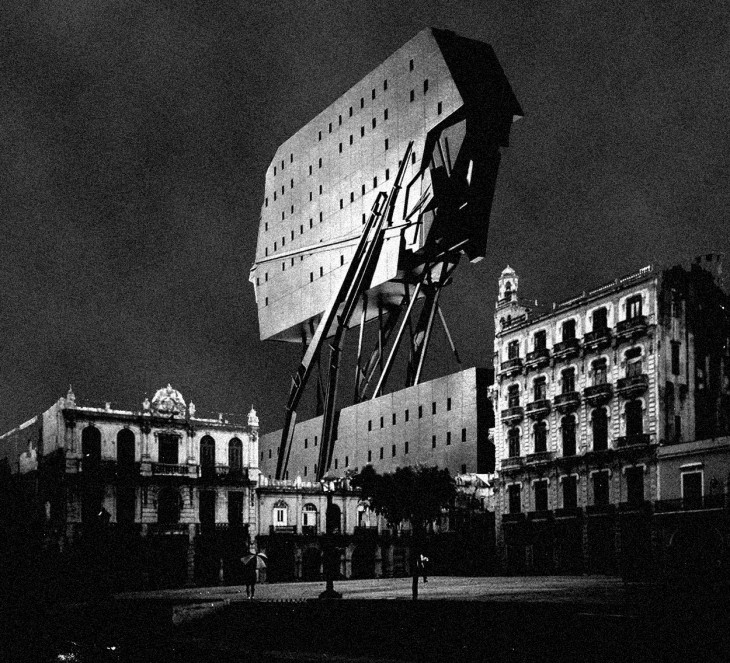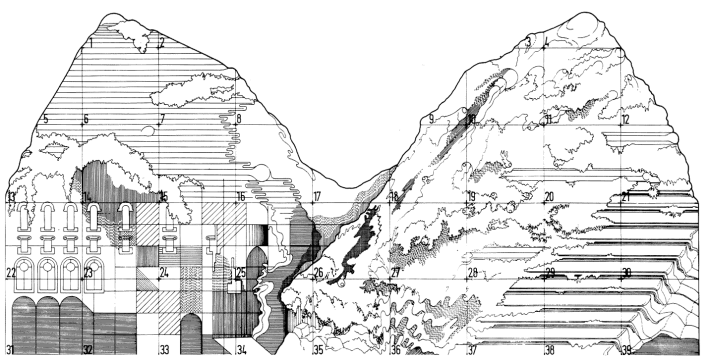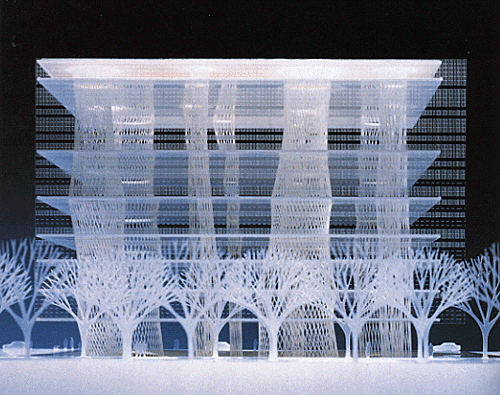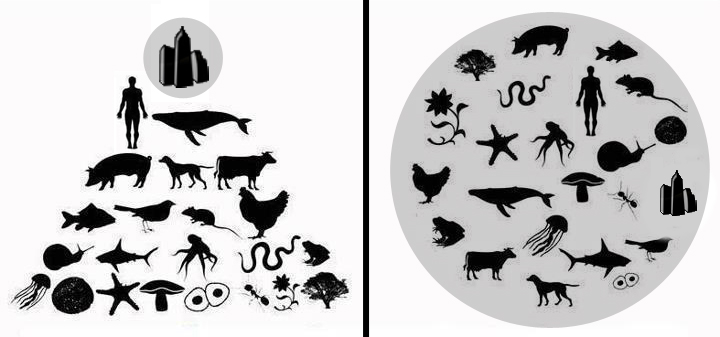The concept of atmosphere troubles architectural discourse- haunting those that try to escape and eluding those that chase it.’
Category Archives: Relational Logic – Critical Readings
Atmospheres Of The Architecture..
Blurred Boundries
Tarzans in the Media forest – Toyo Ito
Peter Cook, Sponge Building 1974
In the text, Toyo Ito questions the 20th century principles of modern architecture and the role of an architect to create artificial environments for human beings. The relationship of buildings with the context in a capitalist economy is complex and the role of the architect is changing and getting redefined. Also this role has an impact of the relationship and events between humans, their habitable space and the city.
ETERNALLY UNDER CONSTRUCTION
The reading, Toyo Ito’s Learning from a Tree, was an intriguing mini-manifesto from the Japanese architect. While his concepts in the opening text felt a bit vague and idealist, the clear references to his ideas in the following case studies embodied his ideologies for architecture of the 21st century. Connections can also be drawn to concepts of architectural systems by relations, as discussed in class.
In his text, Ito, like many other forward-thinking architects, uses modernism as the scapegoat for many problems in contemporary society. He argues that we must move more and more away from the functionalist, pure, lucid geometries and homogenous spaces that dominate our lives and, by learning from the tree, restore a vivid and rich humanity. The tree is a very strong metaphorical relation that he constantly refers to. He says that architects today must not just build sustainably, but humans must sense the nature that they are a part of through the buildings they live in. The integration of nature and architecture that is prominent in Asian cities should be taken to the form of a highrise. “Architecture like a tree that spreads its branches widely.” He refers to a tree extending vertically and horizontally to its physical effect to photosynthesize, and says that architecture must adopt a similar fractal shape. Architecture should still be based on simple rules and geometry, but should be composed with a complex order, much like that of a tree. With this fractal geometry, inside/outside boundaries are blurred, resulting in creating ambiguous, adaptable spaces in architecture. In addition to obvious environmental relations, such as the need to constantly be open to the environment, it was the difference between atmospheric and disturbed relations that struck me as a key paradox. Toyo Ito is a strong believer that architecture must “not be unequivocally decided, but begin with a loose image that is gradually clarified by repeating various simulations.” He again returns to the tree, mentioning that through studies with biologists he discovered that a certain tree’s growth is not just based on its DNA, but also with interrelations with its surrounding environment. This repeated feedback between the tree and the environment, which defines its evolving shape/role is a strong atmospheric relationship. Having said this though, it is also important to note that each tree in nature, as he says, egotistically insists on its presence so as to maintain dominance over others (a disturbed relation). He compares this inner fight to nations, corporations, and people in capitalism. The main difference is that while the tree has this ego to put itself above others, unlike capitalism, it succeeds through interrelations with its immediate environment and the ability for change within its thick roots. The balance of atmospheric (interrelating) and disturbed (destructive) relations can therefore be drawn to architecture. How does our architecture of the 21st century accommodate for the two in tandem? If we must remove ourselves from the modernist machine, how will our new capitalist trees survive? These are questions Toyo Ito has for the next generation of architects, but he has already started to answer them, no better than in the example of his Sendai Mediatheque, a project which he claims changed his views on architecture.
The Sendai Mediatheque is a very apt case for Ito’s manifestos as he confesses that even years after the completion of the building, he feels that the building is “eternally under construction”, like the metaphor of the tree, that can adapt and interrelate with its environment, or in the case of the Mediatheque, its users. The lack of a fixed program gives the building a never-ending sense of evolution, adaptation, and mystery. As he puts it well himself, “architecture without an archetype is for me ideal architecture.” These themes of eternal construction and incompleteness have inspired me in my personal work and research this term at IaaC. Working in the wind ‘social’ energy studio, we are focused on integrating our low-frequency piezo energy harvester device with Valldaura’s trees. Our aim is to use the energy produced on site to emit sounds to attract a host of birds, insects and small mammals to a specific tree. We hope to create a network of such trees, and through the attraction of native species back to the Valldaura, promote a system of controlled pollination in the area, which from our research, is seriously lacking. At the moment the design of our product is too homogenous, it is like a frozen moment of a myriad of possibilities to enhance wind flow through our device. Our goal therefore is to leave this archetype and instead focus our study on adaptable forms, concepts, and materials. Much like Ito’s Mediatheque that doesn’t have a fixed program, our device will not have a fixed shape or fixed tree it will be interrelating with. Our aim is to create a highly integrated and advanced product (with a certain ego) that succeeds due to its ability to play our various simulations due to its loose image and fractal shape. Embraced by Valldaura’s society and eternally under construction. Ito would be proud, I hope.
Through the cave
What’s a cave?
In Primitive future, Sou Fujimoto presents criterions for the ideal architecture of the 21st century. His reflexion on innovation in designing space is based on the comparison between the cave and the nest, the cave being the optimum form of architecture. He suggests looking into the concept of a cave, a primal space that precedes the concept of inhabiting. Read More
No More Inside No More Outside
<Tarzan in the Media Forest> – Toyo Ito
In the chapter ‘Learning from a Tree’, Toyo Ito starts with a demolition of a functional hospital building for a high rise construction for ‘economic development’. Albeit the disappointment he gathered three young ‘Tarzans’ to look into a possibility to establish a high rise structure that has a logical connection to the low rise surroundings by taking an example from the nature, a tree, that (a) has an inverted pyramid form that receives the maximum sunlight and allows a big public space on the ground level, (b) has a fractal form that repeats the geometry in a diminishing scale as it expands which blurs the inside/outside boundary, (c) is based on simple rules but composed in a complex order, (d) is not designed equivocally as it should only be clarified by various simulations, and (e) is open to the environment. Toyo Ito sees this way of thinking architecture (learning from a tree) as a chance to save ourselves from the deteriorating habitat.
Toyo Ito lists out three main points that have influenced his thinking as an architect in the 40 years that Japanese architecture had been influenced deeply by the economic and technological boom.
- While the development of technology finally managed to achieve the ‘dream of future cities’ of the architects, Toyo Ito, being one of them, saw the negative impact that collapsed his ‘future dream’. Instead of being benefited by the technology, the human are instead being dominated. Architecture has lost its value and importance in the technological era. As the technology brings people far from reality, architecture is no longer ‘creative’. He gives an example of a work of Kenzo Tange ‘House in White’, designed the extreme simplicity and tension, which he sees as a criticism of the society of that period, as ‘there is no future for architecture’.
- As Japan steps into a higher level of economic achievement, the value of land price has far transcended the value of architecture. Toyo Ito uses the word ‘intoxication’ to describe the society’s expectation to the idea of ‘city’. Architecture has become an empty structure that can be easily taken off and replaced. It is seen as an ‘abstraction’ in combination with ‘fiction’ that has an unprecedented level of transparency and lightness.
- Toyo Ito won the competition of the Mediatheque in Sendai. He claims that in the winning proposal he designed an extremely light structure with illogically thin elements, as he focused on obsessive beauty, abstraction and emptiness, which created an architecture with no architectural model (archetype) precedent. When it got to construction (reality) almost every element changed in terms of thickness and lightness that the real building looked completely different. People started to question the meaning and use of the building. With the never ending wonders the mediatheque remains ‘incomplete’ even after the finish of construction. Though the design has lost its ‘beauty’, it has been brought closer to the reality. The building has become his ultimately ideal architecture.
Toyo Ito expresses his aspiration to bring up young architects (Tarzans) in a way that they don’t rely exclusively on technology, as the way of thinking architecture should be reconciled with the nature (non-technology) . The development of technology should instead be used as a benefit to achieve the complex pattern of the nature, that has no boundary within each element. In this world of technology we as architects should not forget human as the reality, and always question ourselves about what we truly need in terms of architecture.
As a ‘Tarzan’ I genuinely agree with Toyo Ito’s view on the use of technology that has made us ‘inept’. We have lost the fundamental skills to achieve tasks.
Possible topic: As Toyo Ito mentions in the introduction the fractal geometry creates an ambiguous boundary of inside/outside, I would like to explore more on fractal forms of architecture that reconciles with the natural environment. In such way instead of standing on its own being disconnected with the other elements, architecture should be one of the various elements in the whole system, in which sustainability could only be achieved.





